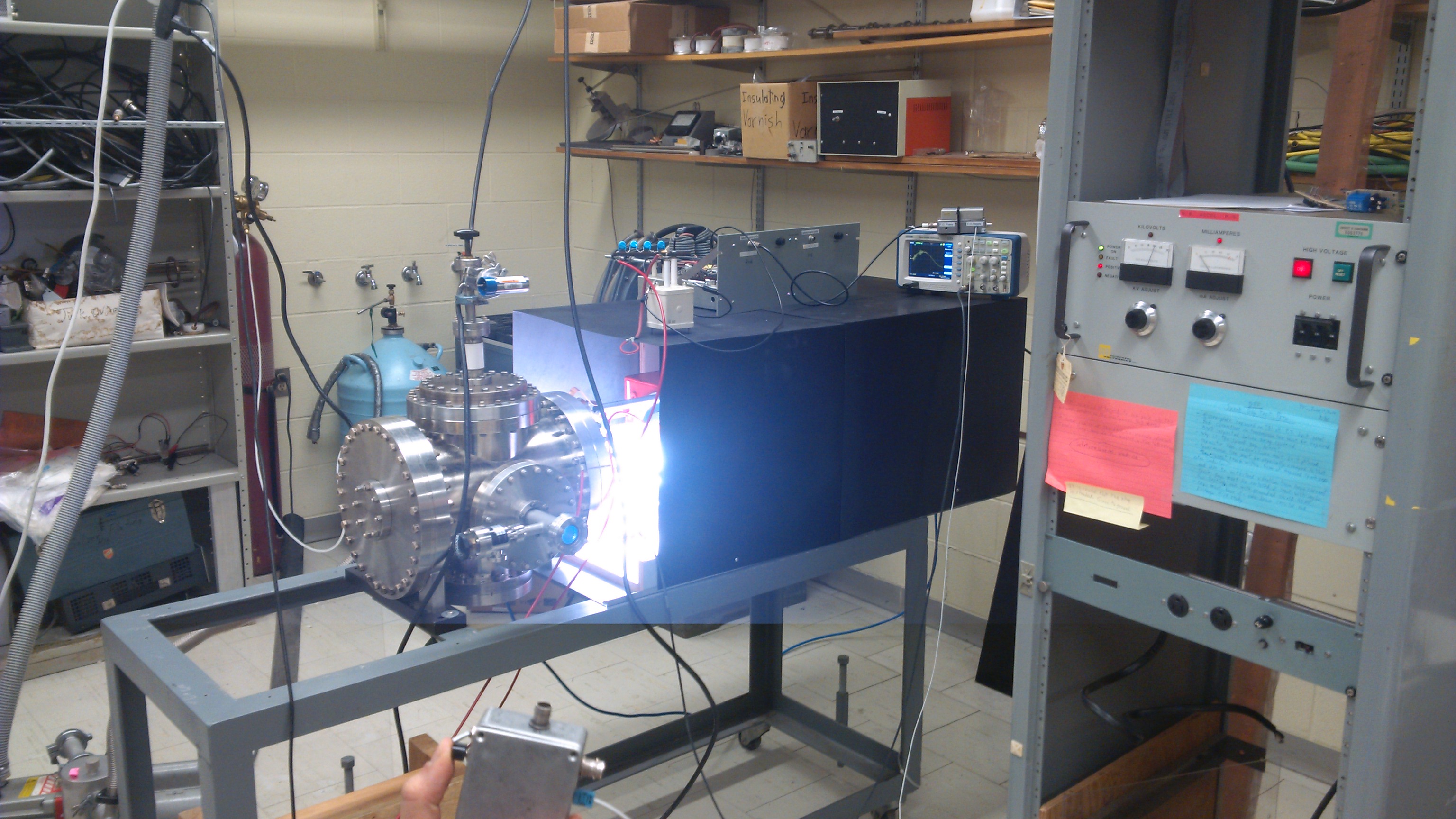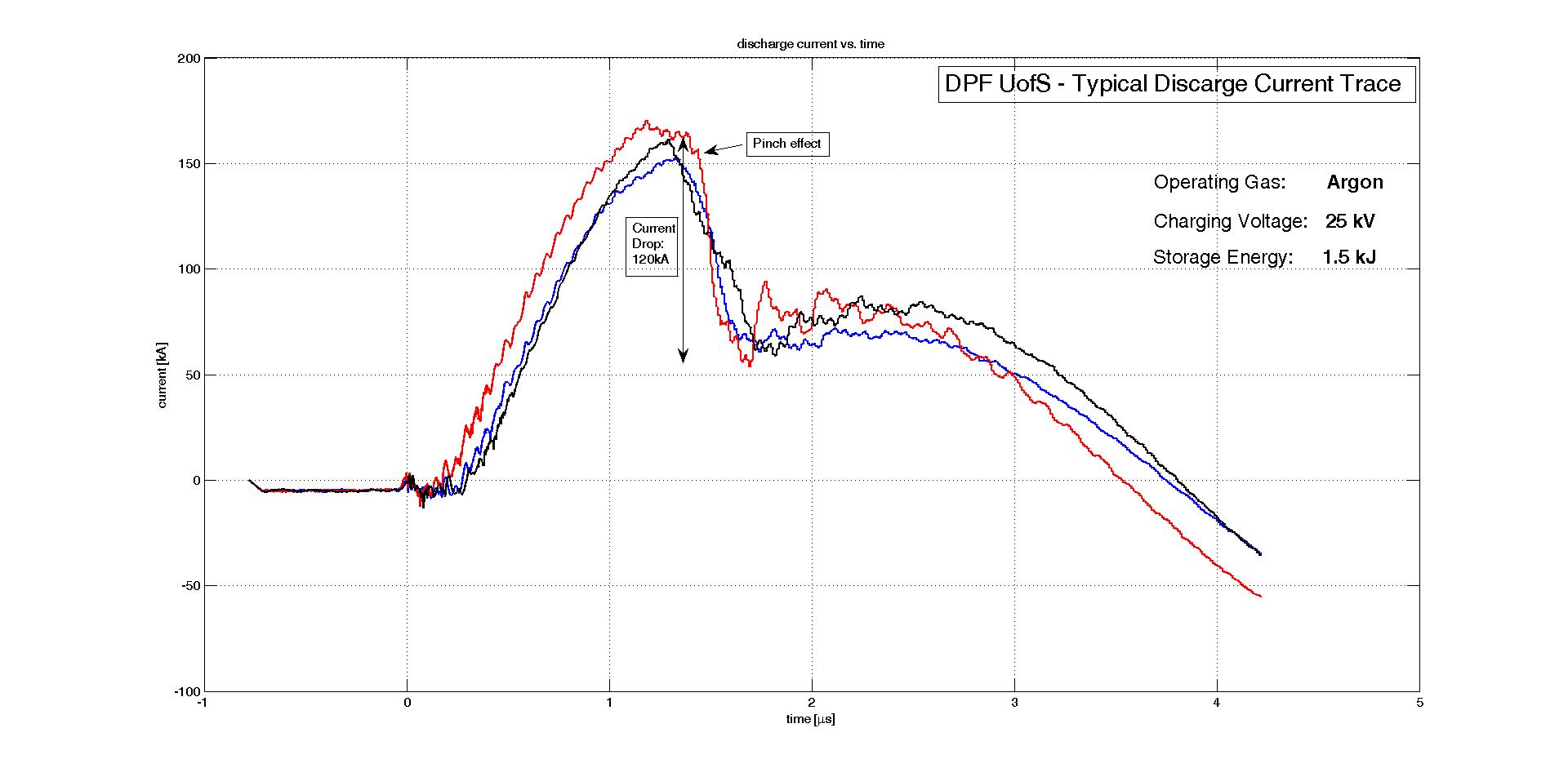Magnetic Fusion
STOR-M Tokamak
The STOR-M tokamak is a research tokamak designed and built in the Laboratory for studies on plasma heating, anomalous transport, and developing novel tokamak operation modes and advanced diagnostics. After the closure of Tokamak de Varennes in 1997, STOR-M is the only device in Canada devoted to magnetic fusion. Efforts are being made to revitalize fusion research in Canada which is the only G8 country not participating in the ITER program.
|
Major Radius |
46 cm |
|
Minor Radius |
12.5 cm |
|
Toroidal Magnetic Field |
0.5 ~ 1 T |
|
Plasma Current |
30 ~ 60 kA |
|
Electron Density |
1 ~ 3 x 10^13/cm^3 |
|
Electron Temperature |
2 ~ 300 eV |
|
Confinement Time |
2 ~ 5 msec |
STOR-M is equipped with a sophisticated feedback control system for horizontal and vertical plasma positions, a driver for fast rising Ohmic current, a circuit system for alternating current (ac) operation, Compact Torus Injector, and various diagnostic instruments. In the following, major experiments carried out with STOR-M are their impacts on tokamak research are described.
Alternating Current (ac) Tokamak Operation
Stable alternating current operation of a tokamak was first demonstrated in STOR-1M (1987) and subsequently reproduced in STOR-M and the Joint European Torus (JET) at 2 MA currents. Genuine steady state tokamak fusion reactors require non-Ohmic current drive. For example, injection of microwaves at the lower-hybrid resonance frequency is a well developed technology for non-inductive current drive. However, the power requirement for driving multi mega ampere tokamak currents is a significant fraction of reactor output even if a large fraction of the toroidal current is self-generated as the bootstrap current. Inductive (Ohmic) current drive is highly efficient and not subject to plasma density limitation as rf wave current drive. The principal objective of the ac operation experiments carried out on STOR-1M and STOR-M tokamaks is to demonstrate the feasibility of quasi steady state (rather than genuinely steady state) tokamak reactors. Recently, 1.5-cycle ac operation has been achieved in STOR-M without the feared accumulation of impurities during the current reversal phases.
Compact Torus Injection
Compact torus (CT) injection is an emerging new technology to fuel the core of tokamak fusion reactors in the future. Fueling technologies currently available, such as cryogenic deuterium-tritium pellet injection, may not be adequate to fuel directly the core of reactors where most fusion reactions take place. The compact torus is a fully ionized, self-confined high density plasmoid and if accelerated to a velocity larger than the Alfven velocity, it will penetrate deep into a tokamak discharge. The first non-disruptive CT injection has been demonstrated on Tokamak de Varennes using the Compact Toroid Fueller designed and fabricated in the Laboratory under a contract with the Canadian Fusion Fuels Technology Project. Subsequently, a smaller Compact Torus Injector was built with the funds provided by NSERC through the Strategic Program. It was installed on STOR-M in 1995. In addition to expected plasma fueling (increase in the plasma density), CT injection has been found to induce a phenomenon similar to the Ohmic H-mode (high confinement mode) discovered earlier on STOR-1M and STOR-M tokamaks. Similar improved confinement after CT injection has been observed on TdeV as well.
Ohmic H-Modes
H-mode is an improved confinement phase in tokamaks over nominal (L-mode) confinement. In large tokamaks with powerful supplementary heating, transition to H-mode occurs when the heating power exceeds a threshold. In STOR-1M and STOR-M tokamaks, a unique heating method, turbulent heating, developed earlier in the Laboratory for non-tokamak toroidal devices, has been applied. After the current pulse, the plasma confinement time is tripled. This observation of Ohmic H-mode was made first on STOR-1M and later on STOR-M and other tokamaks with various means including fast gas puffing and electrode biasing. The significance of the observation is in demonstrating that there is room for improved confinement even in Ohmic discharges. Concurrent with improved confinement, significant reduction of the fluctuations of plasma density and of magnetic fluctuations at the plasma edge have been observed. The plasma potential is lowered and an edge transport barrier develops. At present, the causality problem remains unresolved, that is, it is not clear plasma auto-biasing is a cause or result of improved confinement
Advanced Plasma Diagnostics
Microwave reflectometry has been developed not only for measuring the amplitude of plasma density fluctuations but also for correlation length measurements which is an important quantity in estimating the anomalous plasma diffusivity. In the core region of STOR-M, plasma density fluctuation measurement based on scattering of 2 mm microwave is being conducted with emphasis on short wavelength modes driven by the electron temperature gradient (ETG mode). X-ray tomography for fast magnetic reconnection phenomena during CT injection is planned. It is also planned to develop novel diagnostics based on far infrared lasers for the ITER through international collaboration.
Materials Processing
Plasma Assisted Materials Synthesis and Processing (Bradley, Hirose, Xiao, Yang)
Research on plasma assisted material synthesis and processing was initiated in the Laboratory four years ago. Carbon nanostructures (diamond films, carbon nanotubes (CNT), carbon nanocones) have been successfully synthesized with a newly developed ion sputtering technology which allows diamond synthesis at unusually low temperatures (as low as 250 C). Several methods have been developed for mass production of carbon nanotubes and the Laboratory is collaborating with a group in Chemical Engineering on industrial applications of CNT. In biomedical applications of diamond and related materials, DLC (diamond-like-carbon) has been coated on polymers (PTFE) to improve its haemocompatibility. (PTFE tubes used in cardiovascular applications tend to develop blood clotting if the diameter is less than 6 mm.) Haemocompatibility tests of PTFE with and without DLS coating have been conducted with human blood. Preliminary results are encouraging: DLC coating reduces platelet activation and adhesion. Field electron emission from the synthesized carbon nanostructures has also been observed. One of the long term objectives of the research is to develop a synthesis technology for diamond semiconductors. Superiority of diamond based semiconductors over silicon based semiconductors is well known but development of fabrication technology has been slow. Another area of high priority is research on super hard composite materials for applications in mechanical and nuclear engineering.Ion Implantation (Bradley)
Plasma ion implantation is an innovative material modification technique whereby controlled quantities of desired impurities are implanted into target materials by applying high-voltage negative pulses to a target immersed in a plasma (a gas of ions and electrons) composed of the ions to be implanted. Material properties are highly dependent on the composition and distribution of impurities within the material; because it allows precisely controlled insertion of impurities at controlled depths, plasma ion implantation is one of the most versatile techniques available for the modification of material properties. A proof-of-concept high-voltage pulser has been designed and built, and is now being tested in the ICP plasma chamber recently acquired by the Laboratory. Preliminary results are encouraging. This high-voltage pulser will be used for high-dose ion implantation of a variety of sample materials, such as conventional and porous silicon, SiO2, and diamond and DLC films.Processing Facilities
Plasma Reactors
Microwave Plasma CVD Reactor (CFI)
Inductively Coupled Plasma CVD Reactor (CFI)
Hot Filament Plasma CVD Reactor
Arc Discharge Plasma CVD Reactor
Ion Implantation ICP Reactor (CFI. Bradley)
Surface Analyses
SEM (Geological Science)TEM (Mechanical Engineering)
Nano-indentometer (Mechanical Engineering)
Raman, AFM, Fluorescence spectroscopy, XRD at SSSC
XAS at CLS and other synchrotron facilities
Results
Some of the progress made in the group is highlighted
Sample Photographs
Electric field aligned growth of carbon nanotubes

Carbon nanotubes have been observed to grow along the direction of local electric field which is not normal to the substrate at the edge. SEM images showing CNTs at different locations on a negatively biased substrate: (a) top-left corner, (b) top edge, (c) top-right corner, (d) left edge, (e) center, (f) right edge, (g) bottom-left corner, (h) bottom edge, (i) bottom-right corner.
Nanocones of diamond and related materials

SEM images of nanocone thin films grown under different deposition conditions (a) daimaond, (b) graphite, (c) diamond and graphite composite). Each cone has a nanosize sharp tip and micron size root. Field electron emission (FEE) properties have been investigated.
Diamond coating on steel alloys

Surface images of diamond films grown for 4 h on Fe-15Cr (a) and Fe-15Cr-5Al (b). Figure (c) shows the morphologies of diamond films grown on Fe-15Cr-5Al for 12 h at different magnifications. Raman spectra corresponding to the above three surfaces are presented in (d).
Synthesis of Tungsten Nanorods

SEM of morphology change with the tungsten hot filament temperatures. (a) at 1600 C; (b) at 1940 C; (c) at 2000 C; (d) at 2160 C.
Light emission from porous (nano-void) silicon

Electroluminescence Spectra of Bandstructure-Engineered Silicon
Theory & Computation (Smolyakov)
Magnetic Fusion
Recent theoretical contributions to magnetic fusion research include: (a) linear stability analyses of the kinetic ballooning mode, electromagnetic drift type mode and finite beta effects on those modes, (b) nonlinear saturation of drift type modes, (c) strong turbulence theory, and (d) Hall MHD. A common objective of these studies is to provide a better understanding of transport in tokamaks which may ultimately lead to control of plasma instabilities and realization of more compact tokamak reactors.
Theory of inductively coupled plasmas
Inductively coupled discharges are widely used plasma sources for material processing reactors, electrode-less RF (radio-frequency) lighting devices, and plasma spectrometers. We study nonlinear and anomalous skin effects in such discharges with a goal of developing new, more efficient plasma sources.
Magnetohydrodynamics of plasmas
Also with mass flow with applications to astrophysical plasmas. This research project aims to clarify the mechanism of the angular momentum transport due to magnetohydrodynamic instabilities in high beta plasmas such as plasmas in accretion disks around the black holes as well as to investigate whether similar instabilities may be operative in colder protostellar disks and winds. We also study the effects of convective instabilities that may exist in a stratified plasma that is too weakly ionized for magnetorotational instabilities.




